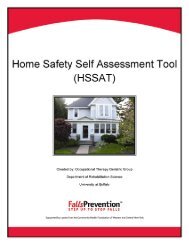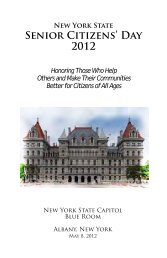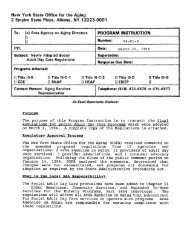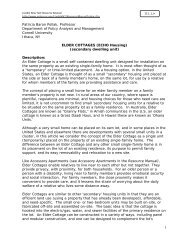Sustaining Informal Caregivers - New York State Office for the Aging
Sustaining Informal Caregivers - New York State Office for the Aging
Sustaining Informal Caregivers - New York State Office for the Aging
You also want an ePaper? Increase the reach of your titles
YUMPU automatically turns print PDFs into web optimized ePapers that Google loves.
When asked about how caregivers rate <strong>the</strong> overall quality of <strong>the</strong> care receiver services:<br />
• 64 percent of <strong>the</strong> survey respondents rated <strong>the</strong> services as excellent or very good;<br />
• 27 percent rated <strong>the</strong> services as good; and<br />
• 12 percent rated <strong>the</strong> services as fair or poor.<br />
Eighty-four percent of <strong>the</strong> caregivers would recommend <strong>the</strong> care receiver services to a friend.<br />
Benefits of Caregiver and Care Receiver Services<br />
<strong>Caregivers</strong> reported that <strong>the</strong> services <strong>the</strong>y received assisted <strong>the</strong>m in providing care <strong>for</strong> care<br />
receivers in many ways. For example:<br />
• 73 percent stated <strong>the</strong> services resulted in benefits to care receivers;<br />
• 59 percent suggested that <strong>the</strong> services enabled <strong>the</strong>m to provide care longer; and<br />
• 56 percent stated that <strong>the</strong> services helped <strong>the</strong>m be more confident about caregiving.<br />
O<strong>the</strong>r benefits from <strong>the</strong> services include: helped caregivers better understand how to get services,<br />
improved caregivers’ knowledge about care receivers’ illness, helped <strong>the</strong>m feel less stress, gave<br />
<strong>the</strong>m more personal time, and assisted <strong>the</strong>m in receiving o<strong>the</strong>r benefits.<br />
Service Outcomes<br />
The mission of NYSOFA/AAAs is to assist older adults to live as independently as possible in<br />
<strong>the</strong>ir home in <strong>the</strong> community <strong>for</strong> as long as possible. Survey responses demonstrated that <strong>the</strong><br />
services provided to caregivers and care receivers help achieve this goal.<br />
When caregivers were asked about whe<strong>the</strong>r care receivers would continue to live in <strong>the</strong> same<br />
home if caregiver and care receiver services had not been provided, only 48 percent of <strong>the</strong> survey<br />
respondents said that <strong>the</strong> care receivers would be able to stay in <strong>the</strong>ir current home if <strong>the</strong> services<br />
had not been provided, while 52 percent reported that <strong>the</strong>ir care receivers would not be able to<br />
continue to live in <strong>the</strong>ir homes if NYSOFA/AAA services had not been provided.<br />
Of <strong>the</strong> 52 percent of caregivers who reported that <strong>the</strong>ir care receivers would not be able to<br />
continue living in <strong>the</strong>ir same home without aging network services, 50 percent of this subgroup<br />
reported that <strong>the</strong> care receiver would live in a nursing home if <strong>the</strong> services had not been<br />
provided; 24 percent reported that <strong>the</strong> care receiver would live in an assisted living facility; 11<br />
percent reported that <strong>the</strong> care receiver would move in with <strong>the</strong> caregiver; 7 percent reported that<br />
<strong>the</strong> care receiver might have died without services; 4 percent reported that <strong>the</strong> care receiver<br />
would live in <strong>the</strong> home of ano<strong>the</strong>r family member or friend; and 4 percent reported that <strong>the</strong> care<br />
receiver might be in a hospital, rehabilitation center or have around-<strong>the</strong>-clock help.<br />
Projecting <strong>the</strong> survey findings to be applicable to care receivers of <strong>the</strong> total surveyed caregivers,<br />
<strong>the</strong> potential outcomes <strong>for</strong> care receivers if aging network services had not been provided<br />
include:<br />
• Would live in a nursing home (26 percent);<br />
• Would live in an assisted living facility (12 percent);<br />
14








